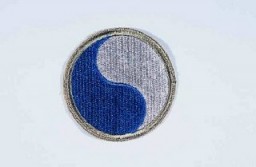<< Previous | Displaying results 576-600 of 2611 for "" | Next >>
-
Evian Conference delegates
PhotoBritish Zionist leader Norman Bentwich (left) with Henri Berenger, French delegate to the Evian Conference on Jewish refugees. Evian-les-Bains, France, July 1938.

-
Myron Taylor at the Evian Conference
PhotoMyron Taylor, US delegate to the Evian Conference, pleads for the establishment of an intergovernmental committee to facilitate Jewish emigration. Evian-les-Bains, France, July 15, 1938.
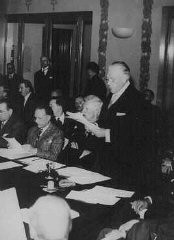
-
Myron Taylor
PhotoUnited States delegate Myron Taylor delivers a speech at the Evian Conference on Jewish refugees from Nazi Germany. Evian-les-Bains, France, July 15, 1938.
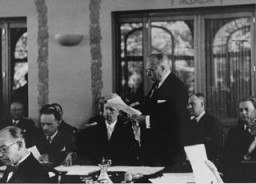
-
Evian-les-Bains
PhotoPostcard showing Evian-les-Bains, a French resort of Evian on Lake Geneva, at the time of the 1938 Evian conference on refugees.
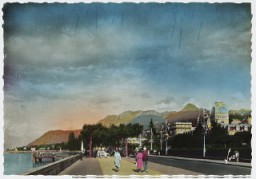
-
Barracks at the Flossenbürg camp
PhotoBarracks for prisoners at the Flossenbürg concentration camp, seen here after liberation of the camp by US forces. Flossenbürg, Germany, May 5, 1945.

-
View of the Flossenbürg camp
PhotoView of the Flossenbürg concentration camp after the liberation of the camp by US forces. Flossenbürg, Germany, 1945.

-
Execution site in Flossenbürg
PhotoExecution site in the Flossenbürg concentration camp, seen here after liberation of the camp by US armed forces. Flossenbürg, Germany, after May 1945.
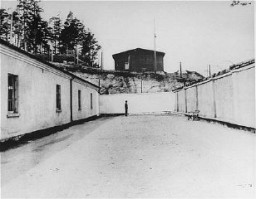
-
Crematorium oven in Flossenbürg
PhotoAfter the liberation of the Flossenbürg camp, a US Army officer (right) examines a crematorium oven in which Flossenbürg camp victims were cremated. Flossenbürg, Germany, April 30, 1945.

-
Caring for survivors of Wöbbelin
PhotoSurvivors of the Wöbbelin camp wait for evacuation to an American field hospital where they will receive medical attention. Germany, May 4-6, 1945.

-
Survivors at Wöbbelin
PhotoSurvivors in a barracks at the Wöbbelin concentration camp. Germany, May 4–5, 1945.
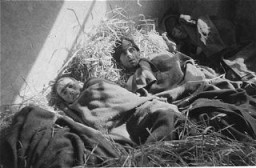
-
Burial of victims of the Wöbbelin camp
PhotoAfter the liberation of the camp, the US Army ordered the local townspeople to bury the corpses of prisoners killed in the camp. This photograph shows troops observing a moment of silence at a mass funeral for victims of the Wöbbelin camp. Germany, May 7, 1945.
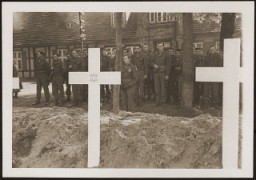
-
Burial of victims of Wöbbelin
PhotoGerman civilians from Ludwigslust file past the corpses and graves of 200 prisoners from the nearby concentration camp of Wöbbelin. The US Army ordered the townspeople to bury the corpses on the palace grounds of the Archduke of Mecklenburg. Germany, May 7, 1945. Outraged by what they found upon entering the camp, the ranking Allied commanders in the area forced civilians from the nearby towns of Schwerin, Hagenow, and Ludwigslust to view the concentration camp and then bury the bodies of prisoners…
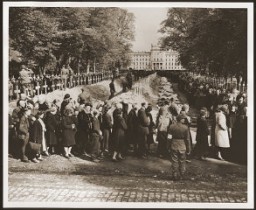
-
Funeral for victims of Wöbbelin
PhotoAfter the liberation of the Wöbbelin camp, US troops forced the townspeople of Ludwigslust to bury the bodies of prisoners killed in the camp. This photo shows US troops assembled at the mass funeral in Ludwigslust. Germany, May 7, 1945.
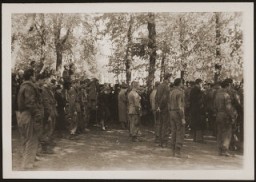
-
German civilians from Schwerin attend funeral services for Wöbbelin victims
PhotoUnder orders from officers of the US 8th Infantry Division, German civilians from Schwerin attend funeral services for 80 prisoners killed at the Wöbbelin concentration camp. The townspeople were ordered to bury the prisoners' corpses in the town square. Germany, May 8, 1945.

-
Flags of US Army liberating divisions
PhotoFlags of US Army liberating divisions on display at the United States Holocaust Memorial Museum in Washington D.C.
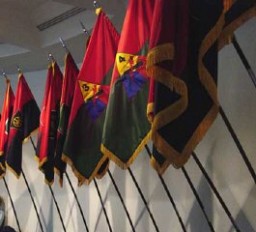
-
Flags of liberating divisions
PhotoFlags of liberating divisions are presented during a ceremony at the Museum's Tribute to Holocaust Survivors: Reunion of a Special Family. This tribute was one of the United States Holocaust Memorial Museum's tenth anniversary events. Washington, DC, November 2003.

-
Tribute to Holocaust Survivors
PhotoBen Meed, President, American Gathering of Jewish Holocaust Survivors, standing in front of flags of the liberating divisions. This photograph was taken as he spoke at a ceremony held during the United States Holocaust Memorial Museum's Tribute to Holocaust Survivors: Reunion of a Special Family. This was one of the Museum's tenth anniversary events. Washington, DC, November 2003.

-
Elie Wiesel
PhotoElie Wiesel became Founding Chairman of the United States Holocaust Memorial Council in 1980. Here, he speaks at a ceremony held during the Tribute to Holocaust Survivors, one of the Museum's tenth anniversary events. Flags of US Army liberating divisions form the backdrop to the ceremony. Washington, DC, November 2003.

-
Tribute to Holocaust Survivors
PhotoView of a ceremony held during the Museum's Tribute to Holocaust Survivors: Reunion of a Special Family, one of the United States Holocaust Museum's tenth anniversary events. Flags of the liberating divisions form the backdrop to the ceremony. Washington, DC, November 2003.
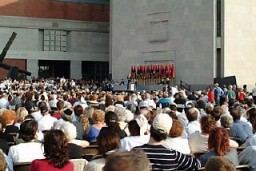
-
2001 Days of Remembrance ceremony
PhotoScene during the 2001 Days of Remembrance ceremony, in the Rotunda of the US Capitol. Flags of the liberating divisions feature prominently in the Museum's Days of Remembrance ceremonies. Washington, DC, 2001.
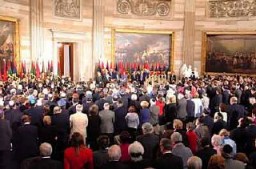
-
Insignia of the 65th Infantry Division
PhotoInsignia of the 65th Infantry Division. The 65th Infantry Division was nicknamed the "Battle Axe" after the divisional insignia, a halbert (an axe on a pole), used to cut through the enemy during medieval times.

-
Insignia of the 45th Infantry Division
PhotoInsignia of the 45th Infantry Division. The 45th Infantry Division gained its nickname, "Thunderbird" division, from the gold thunderbird. This Native American symbol became the division's insignia in 1939. It replaced another previously used Native American symbol, a swastika, that was withdrawn when it became closely associated with the Nazi Party.
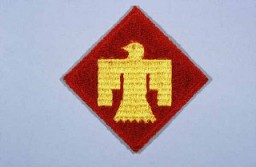
-
Insignia of the 42nd Infantry Division
PhotoInsignia of the 42nd Infantry Division. The nickname of the 42nd Infantry Division, the "Rainbow" division, reflects the composition of the division during World War I. The division was drawn from the National Guards of 26 states and the District of Columbia. It represented a cross section of the American people, as the rainbow represents a cross section of colors.

-
Insignia of the 36th Infantry Division
PhotoInsignia of the 36th Infantry Division. The 36th Infantry Division, the "Texas" division, was raised from National Guard units from Texas and Oklahoma during World War I. The "T" in the division's insignia represents Texas, the arrowhead Oklahoma. The division was also sometimes called the "Lone Star" division, again symbolizing its Texas roots.
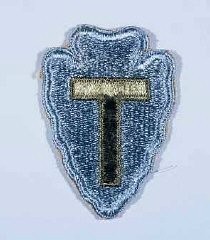
-
Insignia of the 29th Infantry Division
PhotoInsignia of the 29th Infantry Division. "Blue and Gray" was coined as the nickname of the 29th Infantry Division by the division's commander during World War I. The name commemorates the lineage of the mid-Atlantic states' National Guard units that formed the division, many with service on both sides during the Civil War.
